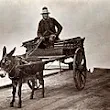Costermonger, coster, or costard is a street seller of fruit and vegetables, in London and other British towns. The term is derived from the words costard (a now extinct medieval variety of large, ribbed apple) and monger (seller), and later came to be used to describe hawkers in general. Some historians have pointed out that a hierarchy existed within the costermonger class and that while costermongers sold from a handcart or animal-drawn cart, mere hawkers carried their wares in a basket.
Costermongers met a need for rapid food distribution from the wholesale markets (e.g., in London; Smithfield for meat, Spitalfields for fruit and vegetables or Billingsgate for fish) by providing retail sales at locations that were convenient for the labouring classes. Costermongers used a variety of devices to transport and display produce: a cart might be stationary at a market stall, a mobile (horse-drawn or wheelbarrow) apparatus or a hand-held basket might be used for light-weight goods such as herbs and flowers.
Costermongers experienced a turbulent history, yet survived numerous attempts to eradicate their class from the streets. Programmes designed to curtail their activities occurred during the reigns of Elizabeth I, Charles I and reached a peak during Victorian times. However, the social cohesion within the coster community, along with sympathetic public support, enabled them to resist efforts to eradicate them. As highly visible, colourful characters who provided service and convenience to the labouring classes, costermongers enjoyed a high level of public sympathy at times when they came under attack from authorities.
They became known for their melodic sales patter, poems and chants, which they used to attract attention. Both the sound and appearance of costermongers contributed to a distinctive street life that characterised London and other large European cities, including Paris, especially in the 18th and 19th centuries. Their loud sing-song cry or chants used to attract attention became part of the fabric of street life in large cities in Britain and Europe. Costermongers exhibited a distinct identity. Individuals signalled membership of the coster community through a dress code, especially the large neckerchief, known as a kingsman, tied round their necks. Their hostility towards the police was legendary. The distinctive identity and culture of costermongers led to considerable appeal as subject-matter for artists, dramatists, comedians, writers and musicians. Parodies of the costermonger and his way of life were frequent features in Victorian music halls. Costermongers were ubiquitous in mid-Victorian England, but their numbers began to decline in the second half of the 20th-century when they began to take up pitches in the regulated markets."Costermongers were known to have been in London from at least the 15th century, and possibly much earlier. Mayhew, writing in the 1840s, called costermongering an "ancient calling" and attributed the first written descriptions of the street sellers' distinctive cries and sales patter appearing in a ballad, entitled London Lyckpeny by John Lydgate probably written in the late 1300s and first performed around 1409."
Costermongers met a need for rapid food distribution from the wholesale markets (e.g., in London; Smithfield for meat, Spitalfields for fruit and vegetables or Billingsgate for fish) by providing retail sales at locations that were convenient for the labouring classes. Costermongers used a variety of devices to transport and display produce: a cart might be stationary at a market stall, a mobile (horse-drawn or wheelbarrow) apparatus or a hand-held basket might be used for light-weight goods such as herbs and flowers.
Costermongers experienced a turbulent history, yet survived numerous attempts to eradicate their class from the streets. Programmes designed to curtail their activities occurred during the reigns of Elizabeth I, Charles I and reached a peak during Victorian times. However, the social cohesion within the coster community, along with sympathetic public support, enabled them to resist efforts to eradicate them. As highly visible, colourful characters who provided service and convenience to the labouring classes, costermongers enjoyed a high level of public sympathy at times when they came under attack from authorities.
They became known for their melodic sales patter, poems and chants, which they used to attract attention. Both the sound and appearance of costermongers contributed to a distinctive street life that characterised London and other large European cities, including Paris, especially in the 18th and 19th centuries. Their loud sing-song cry or chants used to attract attention became part of the fabric of street life in large cities in Britain and Europe. Costermongers exhibited a distinct identity. Individuals signalled membership of the coster community through a dress code, especially the large neckerchief, known as a kingsman, tied round their necks. Their hostility towards the police was legendary. The distinctive identity and culture of costermongers led to considerable appeal as subject-matter for artists, dramatists, comedians, writers and musicians. Parodies of the costermonger and his way of life were frequent features in Victorian music halls. Costermongers were ubiquitous in mid-Victorian England, but their numbers began to decline in the second half of the 20th-century when they began to take up pitches in the regulated markets."Costermongers were known to have been in London from at least the 15th century, and possibly much earlier. Mayhew, writing in the 1840s, called costermongering an "ancient calling" and attributed the first written descriptions of the street sellers' distinctive cries and sales patter appearing in a ballad, entitled London Lyckpeny by John Lydgate probably written in the late 1300s and first performed around 1409."

